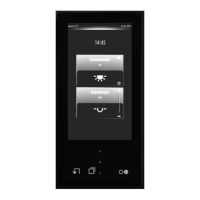Art. No. SC 1000 KNX
Slider
In the selection operation, a slider (E) is available in addition to the sensor surfaces + or - for
operating switching or continuous dimming processes (figure 31). It is possible to specify
brightness values directly with graphic support using the slider. For this purpose, the slider can
be set by finger pressure or continuously moved. To set the slider, you must touch the slider
area at the required brightness level with your finger. The slider then jumps immediately to the
required position. At the same time, the device transmits the brightness value specified thus as
a presetting to the bus.
Alternatively, the slider can be moved continuously in the slider area with your finger. During the
movement of the slider, the device transmits values according to the set value transmitter level
in the ETS time-controlled and gradually. As a result, the brightness of the activated lighting
already changes, for example, during the slider adjustment whereby the operator immediately
receives a visual brightness feedback. The time that must elapse before the device outputs a
new brightness level during an adjustment is defined in the ETS by the parameter "Time
between two value telegrams". Thus, the configured time of the value adjustment and the value
transmitter level have the same effect on the control speed of the slider.
In order for dimming processes to take place continuously and interruption-free when moving
the slider, times as small as possible (e.g. 500 ms) and larger increments (e.g. 20...25%) should
be configured if the slider is moved rather quickly. If, however, the slider is normally moved
slowly, longer times between value telegrams (e.g. 1...2s) and smaller increments
(e.g. 10...15%) are advisable.
If the parameter for the value transmitter level is set to "not to be transmitted during
adjustment", the device does not transmit intermediate levels to the bus when moving the slider.
In this case, only the final value of the slider adjustment is transmitted.
i The current brightness value of the activated dimming channel is indicated in the sensor
element as a bar graph (see Functional description of the display elements below). The
slider is located graphically before the bar graph and is adapted to the position of the bar
graph if no slider operation occurs. Thus, the slider responds to the feedback telegrams of
the dimmer actuator similarly to the bar graph.
It is generally recommended to move the slider as slowly as possible and to leave your
finger briefly (approx. 1s) on the operating element after reaching the setpoint so that the
status indicator in the bar graph matches the current slider position and ideally no position
correction takes place at the end of the operation.
i It should be noted that for a direct operation no slider is available for continuously changing
the value! Here, a value can be adjusted to the value transmitter levels configured in the
ETS by means of a long top-bottom operation of the sensor surfaces.
Status elements
The display area contains different display elements (figure 31) that are influenced by ETS
parameters. A name can be assigned to each KNX channel in the ETS (A). This text name is
centred in the display element for display whereby controllable KNX functions are identified for
the user (e.g. "ceiling spot"). In addition, a status value (B) can be displayed below the name,
which displays brightness values in plain text ("0...100 %") depending on the object value of the
dimming value feedback of the dimmer actuator addressed. After a device reset, the display
shows "---%" until a feedback object value of the status text is received.
Similarly to the status value, a symbol (C) can be displayed in the lower display area. The
"Lighting" icon is always used. The characteristic of the status icon, in which the brightness
state of the controlled KNX channel can be clearly read ( †, changes depending on the
dimming status: Lighting OFF or low brightness, ‡: Lighting maximum brightness, interim
values by symbol with fewer light beams).
The status value and icon can be omitted optionally.
In the channel function "dimming (brightness value)", a bar graph (D) is displayed in the sensor
element. This bar graph displays brightness values in graphic form based on the object value of
the dimming value feedback of the dimmer actuator addressed. The bar graph rises when the
brightness of the activated lighting becomes greater. Similarly, the bar graph falls when the
brightness decreases. At full deflection, the maximum brightness is set. If the bar graph shows
no deflection, the lighting is switched off.
The bar graphs is always visible and normally supplements the status indication by status value
and status icon. The bar graph is located graphically behind the slider.
Page 87 of 347
Software "Smart Control 501511"
Functional description

